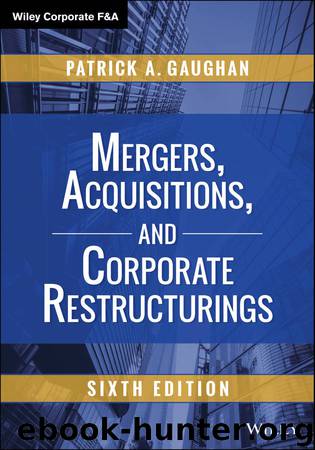Mergers, Acquisitions, and Corporate Restructurings (Wiley Corporate F&A) by Patrick A. Gaughan

Author:Patrick A. Gaughan
Language: eng
Format: mobi
ISBN: 9781119063360
Publisher: Wiley
Published: 2015-04-26T14:00:00+00:00
Going Private (%) M&A (%)
1980s 27.6 30.5
1990s 23.8 31.3
2000–2009 32.8 31.9
2010–2014 31.6 33.6
Total 28.7 31.7
Source: Mergerstat Review, 1992, 1998, and 2015.
Figure 8.6 Going-Private and M&A Median P/Es Offered in the United States. Source: Mergerstat Review, 1992, 1998, and 2014.
When we compare premiums for these recent years, it is useful to note that studies focusing on earlier years found higher premiums. For example, an early study by DeAngelo, DeAngelo, and Rice reviewed 72 MBOs during the period 1973–1980 and found relatively average premiums equal to 56%.15 Other research on buyouts from the 1980s also showed relatively high premiums. For example, Kaplan and Stein found median premiums equal to 43%.16 More recent research by Jerry Cao, focusing on a large sample of 5,305 M&As, of which 844 were LBOs, covering the years 1995–2007, has showed a diminishing pattern of declining premiums.17 Cao's results showed LBO premiums were lower than M&As—consistent with the Mergerstat data discussed earlier. They are also consistent with research by Guo, Hotchkiss, and Song which found the average premium in 192 LBOs over the period 1990-2006 was 29.2%.18
In terms of P/Es offered, the values are similar for both going-private transactions and M&As. Buyers in going-private transactions have tended to pay lower premiums than buyers in M&As (Table 8.2). In addition, Figure 8.6 shows that in relation to earnings per share, the price that is paid in going-private deals often is less than in M&As.
Sources of LBO Gains
In Chapter 4 we reviewed some of the various reasons why companies pay premiums and incur some of the expenses of mergers. They pursue these deals for reasons such as enhancing their growth and realizing synergistic gains, as well as other reasons. Many of these reasons, such as synergies, may not be relevant as for LBOs and MBOs. In MBOs, for example, the company, at least initially, stays independent and does not have the opportunity to combine with another entity and realize synergistic gains. Then what is the source of the gains that allows the acquirer to pay a premium and also incur the financing charges associated with the increased leverage? Research points to several potential sources of these gains, which are discussed in the following sections.
Efficiency Gains
There are several areas in which efficiency gains can manifest themselves in an LBO. The first has to do with agency problems.19 We discuss agency problems in several places in this text. They arise when the true owners of the company, shareholders, have to elect directors to oversee their interests.20 These directors select managers who have a fiduciary responsibility to run the company in a manner that will maximize shareholder wealth. However, managers are human and they may pursue their own agendas and seek to further their own gains at shareholder expense. In doing so, they may not manage the company in a manner that will maximize profits. Managers may know that if they generate an acceptable return, such as πmin in Figure 8.7, it would be difficult for shareholders to mount a successful proxy fight and demand their ouster.
Download
This site does not store any files on its server. We only index and link to content provided by other sites. Please contact the content providers to delete copyright contents if any and email us, we'll remove relevant links or contents immediately.
Hit Refresh by Satya Nadella(8857)
The Compound Effect by Darren Hardy(8518)
Change Your Questions, Change Your Life by Marilee Adams(7378)
Nudge - Improving Decisions about Health, Wealth, and Happiness by Thaler Sunstein(7246)
The Black Swan by Nassim Nicholas Taleb(6770)
Deep Work by Cal Newport(6563)
Daring Greatly by Brene Brown(6228)
Rich Dad Poor Dad by Robert T. Kiyosaki(6182)
Principles: Life and Work by Ray Dalio(5964)
Man-made Catastrophes and Risk Information Concealment by Dmitry Chernov & Didier Sornette(5652)
Playing to Win_ How Strategy Really Works by A.G. Lafley & Roger L. Martin(5510)
Digital Minimalism by Cal Newport;(5394)
Big Magic: Creative Living Beyond Fear by Elizabeth Gilbert(5358)
The Myth of the Strong Leader by Archie Brown(5239)
The Slight Edge by Jeff Olson(5200)
Discipline Equals Freedom by Jocko Willink(5157)
The Motivation Myth by Jeff Haden(5005)
Stone's Rules by Roger Stone(4861)
The Laws of Human Nature by Robert Greene(4778)
